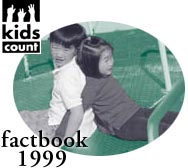
Copyright 1999
Oklahoma Institute for Child Advocacy, Inc.
420 NW 13th Street
Suite 101
Oklahoma City, 73103
Phone: 405-236-KIDS
Fax: 405-236-KIDX
More
Online Information
Related to
Children-at-Risk


![]()
Oklahoma's people remain her strength and promise. One in four (26.5%) Oklahomans are children.
Today, almost eight hundred eighty thousand (878,305) children live, play and go to school in Oklahoma communities.
Tomorrow their ideas and dreams will frame yours. They will have your job, your responsibilities. They will run the businesses and be the workers. One will be your grocer, one your pharmacist. One will be your neighborhood cop, one your child's doctor. Tomorrow they will be the teachers. One will marry your child. Today's children will be tomorrow's policy makers and voters. One will be Governor. They will decide if your grandchildren are safe, healthy and happy.
Today, thousands of Oklahoma children are safe, healthy and happy. Thousands are not. Some will overcome the challenges depicted in these pages. Others will fail.
There is not one child to waste. The problems are complex, but not without promising solutions. Community understanding, combined with action, will improve the well-being of today's children and secure a safe, healthy and happy future for tomorrow's children.
The Oklahoma Kids Count Partnership, a project of Oklahoma Institute for Child Advocacy (OICA), uses key strategies to achieve its goal. First, Kids Count "counts kids," providing accurate and up-to-date data on the status of Oklahoma's children and youth. Second, Kids Count cultivates leadership on behalf of children and youth, giving voice to their needs at the local level. Third, Kids Count communicates the needs of children and youth, using extensive public awareness activities.
The Oklahoma Kids Count Factbook uses benchmarks to profile the status of children and youth in our state. Benchmarks are quantifiable measures that, when taken together, help determine child, family and community well-being. The eight benchmarks in the 1999 Kids Count Factbook are low birthweight infants, infant mortality, births to young teens, child abuse & neglect, child death, child poverty, high school dropouts and juvenile violent crime arrests. This book, the fifth annual Oklahoma Kids Count Factbook, shows the interrelatedness of these benchmarks and how they impact each other.
From an established baseline, OICA is tracking progress, or the lack of progress, for each benchmark over time. Progress requires action. Progress requires using all of this information —and more— to make good decisions about state and community budgets and programs that affect children and youth. Effective programs and policies work together with strong communities and families to improve the benchmarks. A benchmark is not just a collection of numbers; each individual number has a face, a family, and a future.
The 1999 Oklahoma Kids Count Factbook reveals that five of the eight benchmarks tracked worsened when compared to data from a decade or more ago:
- Low birthweight infants
- Child abuse & neglect
- Child poverty
- High school dropouts
- Juvenile violent crime arrests
Three benchmarks improved over the comparable decade-old data:
- Infant mortality
- Births to young teens
- Child death
